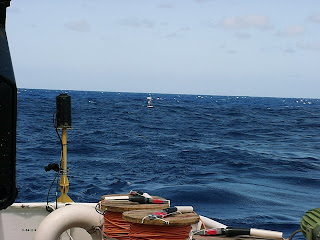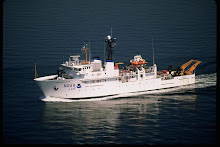 Today was a busy day. We were up before dawn so we could check on an existing buoy close to the location of our new deployment. We made what was called a 'fly-by'. The ship closed on the buoy and at about a mile it was vaguely visible in the early dawn.
Today was a busy day. We were up before dawn so we could check on an existing buoy close to the location of our new deployment. We made what was called a 'fly-by'. The ship closed on the buoy and at about a mile it was vaguely visible in the early dawn. 
 The first buoy deployment of our mission began about 7:30 AM and we had the anchor in the water about 11AM and everything went smooth. The new generation TAO buoy was deployed at 155 W longitude and 8 N latitude in a depth of 5200 meters (about 3.2 miles deep!). The TAO buoys, also called moorings, are anchored to the ocean floor using plastic coated steel cable and heavy rope. We have a drawing of the standard buoy to give you some idea what the whole package looks like, at the surface as well as below. The adjacent image is of the actual buoy that we deployed today. As you can see the color scheme has change to a solid International Yellow above the waterline.
The first buoy deployment of our mission began about 7:30 AM and we had the anchor in the water about 11AM and everything went smooth. The new generation TAO buoy was deployed at 155 W longitude and 8 N latitude in a depth of 5200 meters (about 3.2 miles deep!). The TAO buoys, also called moorings, are anchored to the ocean floor using plastic coated steel cable and heavy rope. We have a drawing of the standard buoy to give you some idea what the whole package looks like, at the surface as well as below. The adjacent image is of the actual buoy that we deployed today. As you can see the color scheme has change to a solid International Yellow above the waterline.

During the initial deployment electronic sensors are placed at specific depths on a special coated steal wire. These sensors are designed to by induction and send information about conductivity (salinity), temperature and sometimes depth to the instrument tube in the buoy.This image shows two of the science team placing one of these sensors on the line.

The information provided by these sensors, and those on the buoy that measure surface conditions, help climate scientists better model the behavior of the ocean atmosphere interface and understand what patterns are more representative of El Nino, La Nina, or Neutral conditions.

In addition to the deploy of this first buoy on our trip, the ship was also engaged in the deployment and recovery of the first deep CTD. This 3000-meter (about 9750 feet or slightly over 1 3/4th miles down) cast went fairly smoothly until it was on its way back to the surface. The winch
controller overheated and the CTD had to rest
for about one hour while the instrument package
sat at 2000 meters. After the control circuits had a chance to cool we were able to continue the recovery of the CTD and resume or course south on the 155 W to our next station at 7N for a 1000 meter CTD cast. There is a good chance that we will do the CTD later this evening since it will take about six hours for the ship to transit one degree depending on sea conditions.
Rick and Art


Art,
ReplyDeleteWe've noticed on the ship tracking that sometimes your ship reports a depth of 0 meters. What causes that to happen? Are you in VERY shallow water or is it a mistake of some kind?
Gary Myers and Rossiter 3rd Graders
Hi Gary,
ReplyDeleteThanks for following us! It is definitely a mistake because we have been putting buoys out in about 5,000 meters of water. I will ask the Chief Scientist about this tommorrww,
Art